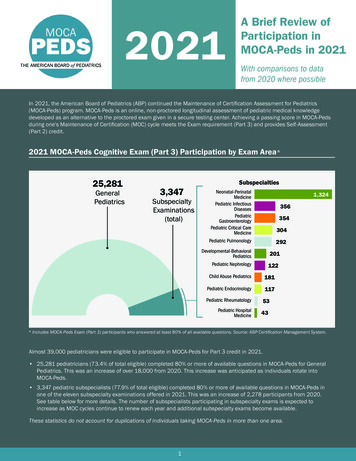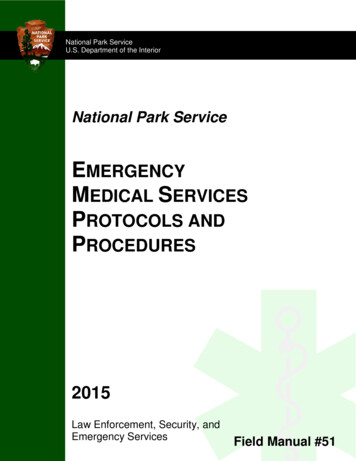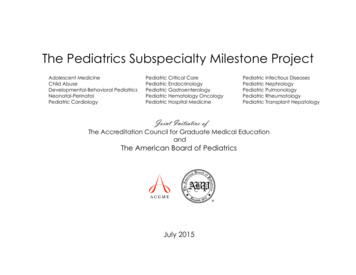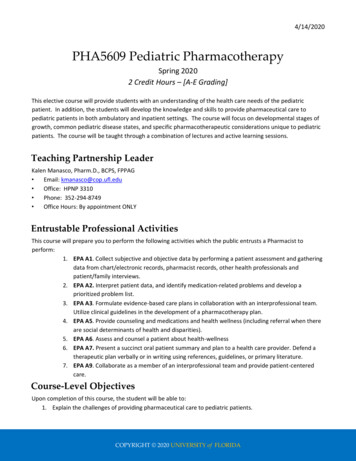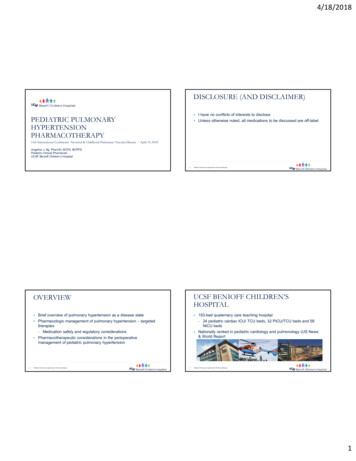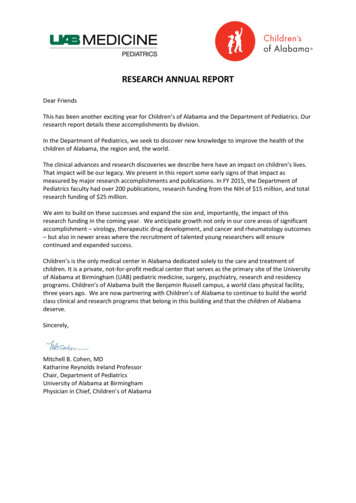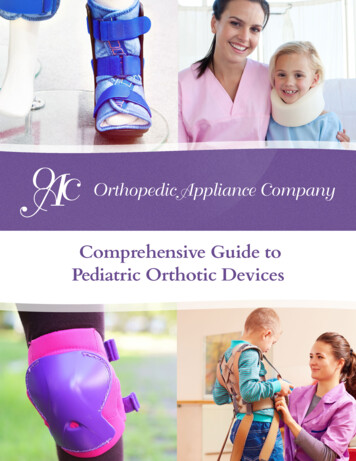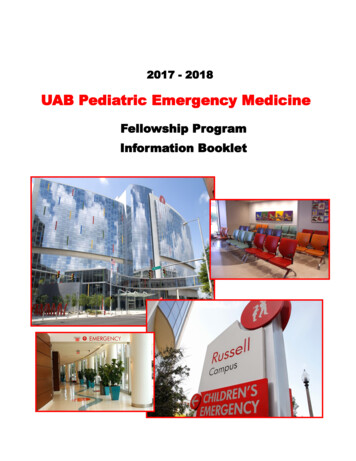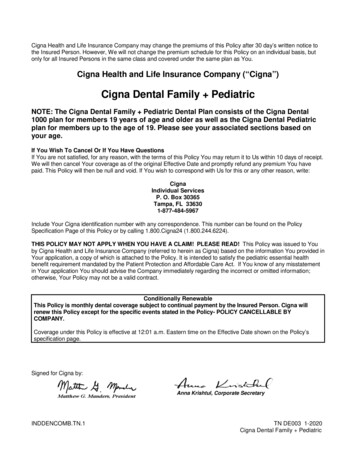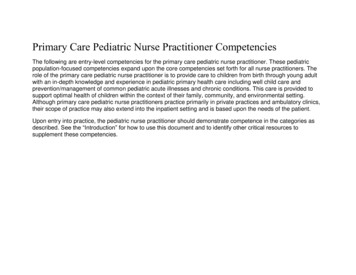
Transcription
Healthcare Transition:Moving from Pediatric to Adult Health Care for Youth and Adults with Autism Spectrum DisorderA Workbook for Families
Table of ContentsWelcome . 2GENERAL INFORMATION . 3Introduction to Autism Spectrum Disorder (ASD) . 4Understanding Health-Related Outcomes. 5How does ASD Affect Healthcare Transition? . 6Communication Tips. 7Rules of 18 . 8What Does it Mean to be an Adult? . 9A Parent’s Health Care Checklist . 10Health Insurance for Young Adults with ASD . 12Healthcare Insurance Activity. 15Paying for Health Care. 23LESSON SYNOPSES . 24Lesson 1: Healthcare Transition Medical Home . 25Lesson 1 Handouts . 27Lesson 2: Healthcare Transition Doctor Appointments. 32Lesson 3: Healthcare Transition Prescription Information . 34Lesson 4: Healthcare Transition Insurance Information . 36Lesson 5: Healthcare Transition Being Prepared. 37Lesson 5 Handouts . 39ADDITIONAL RESOURCES. 43Sample Instructions and Script for Uber or Lyft: Arranging Transportation . 44Internet Resources . 451
WelcomeWelcome to the Transition to Adult Healthcare Workbook for Families!This workbook aids families in supporting the health care transition of youth with autism spectrum disorder (ASD)transition from pediatric to an adult model of healthcare. Your child is participating in a week-long course abouttransition to adult health care.Transitioning from pediatric to adult health care is a process that should involve planning and support from a team. Thisteam consists of a variety of stakeholders, institutions, and individuals, such as the community, educators, the youth,health care providers, other health care assistants, social service workers, and family members like you.Despite the increasing demand in vocational and academic transition services and education for youth with disabilities,current programs are few and lack cohesive structure and effectiveness. Out of these transition programs, health caretransition is a crucial subject that is yet to be covered. Other barriers include lack of providers with sufficient knowledgeand time to work with special needs populations, and a lack of guidance for parents on how to transition their youthfrom pediatric to adult health services. This workbook is designed to bridge the gap in the lack of educational servicesregarding healthcare transition in youth with ASD.The workbook is designed to increase these transition skills: Self-advocacy, planning and scheduling, self-monitoring,and health knowledge.Acknowledging the depth and variance of the autism spectrum, this workbook serves as a guide for the adaptation andimplementation of educational materials. This workbook is broken down into two sections: (1) general healthcareinformation and (2) synopsizes of course lessons. Certain resources may need to be tailored to suit the individual anddevelopmental stage of each child. We look forward to going on this exciting journey with you in making a difference inthe health of youth with ASD.2
GENERAL INFORMATION3
Introduction to Autism Spectrum Disorder (ASD)What is Autism Spectrum Disorder (ASD)?ASD and autism are general terms to describe this complex neurodevelopmental disorder. This disorder/condition isgenerally characterized (in varying degrees) by (1) difficulties in social interaction and communication, and (2) repetitivebehaviors and restricted interests.Prior to 2013 when the most recent version of the Diagnostic and Statistical Manual of the American PsychiatricAssociation, the DSM-5, was published, there were 5 diagnoses that were considered part of the family of autism. Theseincluded Autistic Disorder, Asperger’s disorder, Pervasive Developmental Disorder-not otherwise specified (PDD-NOS),Rett syndrome, and Childhood Disintegrative Disorder. Currently the diagnostic classification system has been simplifiedand all diagnoses fall under Autism Spectrum Disorder (ASD) and are categorized based on the varying levels of supportthat the individual needs.In addition to core impairments in interacting and communicating with others and having unusual interests andbehaviors, people with ASD may also have intellectual disability, motor coordination difficulties, and other comorbidconditions, including seizures, sleep disturbances, and gastrointestinal problems.Many individuals with ASD have accompanying psychiatric symptoms that are not associated with autism. About 70% ofindividuals with ASD may have one comorbid mental disorder and 40% may have two or more. ADHD, anxiety anddepression are some common comorbid disorders.The term “spectrum” refers to the wide range of symptoms, skills, and levels of impairment or disability that individualswith ASD experience. Some individuals may be able to participate in typical activities of daily living with few supportswhile others may need significant support for most activities. All people with ASD have unique needs, but some aremore mildly impaired by their symptoms while others are significantly disabled.4
Understanding Health-Related Outcomes (Taken from Health Care Transition and autism spectrum disorders;Emory Autism Center, 2016)Health care transition is the process of changing from a pediatric to an adult model of health care. The goal of transitionis to optimize health and assist youth in reaching their full potential. Achieving this goal requires an organized transitionprocess to support youth in acquiring independent health care skills, preparing for an adult model of care, andtransferring to new providers without disruption in care.Six Core Element of Healthcare Transition1. Transition Policy: develop transition policy/statement that describes the practice’s approach to transition andeducate staff about this approach; post policy and discuss with families2. Transition Tracking and Monitoring: establish criteria and process for identifying transition-age youth and entertheir data into a registry and track progress3. Transition Readiness: conduct regular transition readiness assessments to identify needs and goals; jointlydevelop and prioritize goals and document regularly4. Transition Planning: develop and regularly update plan of care; prepare for changes once adult turns 18 (legalchanges, policy and consent, self-advocacy, etc.); determine level of need for decision making; plan for timing oftransfer; obtain consent for release of information for guardians; assist with finding adult provider and clarifyresponsibilities of pediatric vs adult provider until transfer5. Transfer of Care: confirm date of first adult provider appointment and make sure transfer happens when youthis medically stable; complete transfer package and send package along with letter to the adult practitioner6. Transfer Completion: contact young adult/caregiver 3-6 months after last pediatric appointment to confirmtransfer of responsibilities; communicate with adult practice confirming completion of transfer; build ongoingand collaborative partnerships between adult and specialty practices5
How does ASD Affect Healthcare Transition? (Taken from Healthcare Transition and Autism SpectrumDisorders; Emory Autism Center, 2016)Spectrum: Because autism exists on a spectrum, each patient’s healthcare transition plan will be fairly unique. There’s no “one sizefits all” transition plan that can be used for everyone that has autism. Each plan will be individualized to address each person’sspecific needs.Structure: Transition will be much more successful if there is a degree of structure to the process. It will be helpful if there is a setschedule for regular doctor’s visits to discuss transition (when they happen, where they happen, how the appointment flows, who isthere, etc.) and this structure/schedule can eventually be transferred to an adult practitioner.Unexpected Changes: Individuals with ASD crave structure and predictability. Anticipation of change and coping with changes areoften challenging for adolescents with ASD. This is something to keep in mind as transition inherently requires change. Any expectedor anticipated changes should be explained to the client clearly, as far in advance as possible, and repeatedly in order to raisehis/her level of comfort.Developmental Disability: Individuals with ASD will have to deal with issues related to his/her specific symptoms throughout his/herwhole life and adjust accordingly. They will often experience social and emotional developmental milestones later than their sameage peers. For example, many young adults with ASD may struggle with abstract concepts such as disclosure and self-advocacy, andthus may benefit from transitioning to adult healthcare after the age of 18 and may need direct instruction and targeted practice inunderstanding these concepts.Executive Functioning: People with autism tend to have poorer executive functioning skills. This will make the logistics of healthcare(e.g., making appointments, showing up on time, filling prescriptions, calling the office, filling out medical forms) much moredifficult. Providing and subsequently fading supports (e.g., visual supports, assistive technology, structured plans) will be helpful toadolescents with ASD.Communication: Most individuals with ASD struggle with everyday communication skills to varying degrees. It is important tounderstand not only how an individual communicates with others (verbal? Non-verbal? Somewhere in between?) but also how wellhe/she understands any receptive communication.Social skills: Difficulties with social skills have the potential to make appointments feel odd or awkward for the nurses, doctors andother healthcare staff. It is important to understand what limitations an individual has in social skills in order to have a successfulinteraction. (For example, just because a client isn’t making eye contact doesn’t mean that he or she isn’t listening).Restricted Interests: People with ASD tend to have extensive knowledge about particular topics that are of interest to them.Knowing an individual’s interests could go a long way in building rapport and engaging the individual with ASD. Depending on theinterest, it could be used to help teach him or her about healthcare needs.Sensory Issues: People with ASD may have various issues related to specific senses (for example, certain lights/sounds may beabrasive to someone with ASD). Therefore, it may be difficult for someone with ASD to adjust to the new sights, sounds, smells, etc.of a new doctor’s office. This may also affect the ease with which patients interact with various medical staff.6
Communication Tips (Taken directly from DPH booklet)People sometimes say that communication is a two-way street. But when it comes to effective communicationand medical appointments for youth it is usually a three-way street:Parent(s) Health care provider YouthTransition is a time of changing roles and expectations. It is a time for youth to actively assume moreresponsibility and for parents as well as health care providers to encourage this change to the greatest extentpossible even when they have special health care needs. Open communication is essential to this process so thatthe three-way street becomes:Youth Health care provider [Parent(s) as needed]Key questions for youth, health care provider, and parent(s) Do I show others the respect that I want to receive?Do I listen carefully and completely to questions or comments before responding?Do I participate in discussions willingly and with an open mind?Do I accept responsibility for my actions and opinions?Do I ask for further explanation when I don’t understand something?Do I actively participate in planning and problem solving?Key questions for youth Do I participate in my appointments by offering information, answering questions, expressing myconcerns, and asking questions?Do I express my own thoughts and feelings even when they differ from my parent(s) or health careprovider?Do I ask for some time alone with my health care provider at my appointments for private discussionand am I able to ask questions without feeling embarrassed?Key questions for providers Do I focus my attention primarily on the youth rather than the parent?Do I discuss topics that are age and developmentally appropriate and include but are not limited to theyouth’s special health care needs?Do I offer time alone with the youth for private discussion?Do I respect confidentiality as much as possible?Do I create a comfortable environment that encourages collaboration?Key questions for parents Do I actively encourage my son or daughter to participate as fully as possible?Do I actively encourage the health care provider to do the same?Do I facilitate confidential communication between my son or daughter and his or her health careprovider to the greatest extent possible?Do I recognize my own legitimate needs as a parent during the transition process and seek appropriatesupports and resources to meet these needs?7
Rules of 18 (taken from DPH’s Taking Charge of my Healthcare)In Georgia, when a person reaches his or her 18th birthday, he or she becomes a legal adult. Unless a guardian has beenappointed through a judge in a court of law, all the rights and responsibilities that are part of being a legal adult go intoeffect. Some of these rights include the ability to: VoteGet married without parental consentMake a will (you can legally make a will at age 14 in Georgia)Make a contract (such as renting an apartment, buying a car, taking out a loan, etc.)Give or refuse consent for medical treatmentMake independent decisions free from parental controlApply for credit (including credit cards)At the age of 18, individuals also have certain legal responsibilities, such as: Self-support (parents are not required to support their adult children unless the youth is enrolled into secondaryschool, then that age of support ends at 20) Serving on Jury Duty if called to do so Being liable for all contracts entered into (such as making loan payments) Every male citizen and immigrant residing in the United States must register with the selective service within 30days of his 18th birthday. Even a male with severe disabilities who could not possibly serve in the military mustregister. Not registering is a federal crime. This does not mean joining the military, as there is no military draftright now where males of certain ages are required to serve in the military. However, the military still needs toknow the name of every male citizen and immigrant living in the United States in case there would be a need fora military draft in the future.8
What Does it Mean to be an Adult? (Borrowed heavily from DPH’s Taking Charge of my Healthcare)Typically, turning 18 is the defining point between being a youth and being an adult, but being prepared for theincreased responsibilities doesn’t happen overnight. These young adults need parents, friends, or other individuals theytrust to help them think through important decisions.In addition, parents also need to understand that they do not continue to be the legal decision-maker for their adult sonor daughter, unless they have legal authority, such as a type of guardianship. Even in situations where severe disabilitiesare involved, adults are presumed to be able to act on their own behalf unless a court of law decides otherwise.The issue of guardianship, conservatorship, and independence is important in making decisions, including healthcaredecisions. The following items are things for the family to consider in deciding the best option for their situation:Guardianship vs. ConservatorshipGuardianshipConservatorship For legally incompetent individuals Not considered legally incompetent A “guardian” is assigned by thecourts to make all decisions forindividual A “conservator” is assigned by the courts toshare or make limited decisions for individual The individual under guardianship iscalled the “ward” The individual under conservatorship is calledthe “conservatee”Sometimes, full guardianship may not be needed. A limited guardianship can be established so that the individual whohas a guardian can still keep some of his/her decision-making rights. A person may need help with legal and financialdecisions, but he/she is still capable of making decisions, such as consenting to undergo a procedure. In this situation,the person may be able to have a guardian for other decisions, but still keep the right to make his/her own healthcaredecisions.9
A Parent’s Health Care ChecklistQuestionYesNotYetFirst StepsDo I know how my teen learns best?Can my teen describe his/her special health care needs?Do we discuss and demonstrate healthy lifestyle habits asa family?Can my teen name his/her doctor?Can my teen communicate that he/she is feeling ill?Can my teen describe symptoms when feeling ill?Do we use a family calendar for tracking appointments,activities, etc.?Is my teen involved when I schedule appointments?Can my teen schedule appointments on his/her own?Do I encourage my teen to give information and answerquestions at appointments?Have I discussed transitioning to adult care providers withmy teen’s present providers?Do I involve my teen in registering or checking in forappointments (showing insurance/Medicaid card, etc.)?Do I involve my teen in filling and refilling prescriptions?Is my teen involved in maintaining/ordering monthlysupplies, equipment or scheduling home care?Do I know what insurance or health care coverage will beavailable to my teen when he/she turns 18?If my teen is on my insurance, do I know how long thatcan continue?Have we talked about and made plans for guardianship(none, full, limited)?Have we discussed and planned for Power of Attorney forHealth Care?10
Do I use formal and/or informal advocacy or supports andis my teen aware of this?11
Health Insurance for Young Adults with ASDHealth insurance is a critical component of healthcare, but also one of the most confusing aspects to navigate.The different types of plans offered, eligibility, coverage, and jargon are especially daunting when trying todecide which healthcare plan is the most appropriate. After you are finished covering this lesson, help yourson/daughter complete the “Health Insurance Activity”.Coverage and InsuranceHealthcare coverage and insurance mean the same thing. There are private and public options. Private plans areusually supplied by an employer or can be purchased through the marketplace. These include large companiessuch as Aetna, Blue Cross Blue Shield, and Kaiser. Public insurance is funded through the government andincludes programs like Medicaid and Medicare.MedicaidMedicaid is a federal insurance program for low-income families and individuals. Medicaid coverage and lawsvary by state, but the federal law mandates that all people under the age of 21 who have Medicaid are entitled toEarly Periodic Screening, Diagnosis, and Treatment (EPSDT) of ASD. States also must cover all medicallynecessary autism-related interventions that count as “medical assistance.”Georgia LawUnder the state of Georgia, anyone who receives Supplemental Security Income (SSI) from Social Securityis automatically eligible for Medicaid. Some allow indefinite continued coverage if the disability occurredbefore age 18, and the parent continues to provide 50% or more of the adult child’s care. Some SSI paymentsare made based on the adult child no longer being claimed as a dependent. Furthermore, there are someprograms that may help youths with ASD or other disabilities. The Katie Beckett program states that at age 18,they may be eligible for SSI even if they had not been previously due to parent income. The COBRA coveragealso states young adults can continue COBRA coverage up to 36 months after leaving the parent’s familyinsurance plan due to losing their status as a dependent, but the individual is responsible for paying individualpremiums. If health and dental plans are offered separately, each plan should be considered separately.Social Security Disability InsuranceThe Social Security Administration has two kinds of benefits for people with disabilities over the age of 18:Supplemental Security Income (SSI) and Social Security Disability Insurance/Disabled Adult Child Benefits(SSDI). Be aware that even if a family is receiving SSI for a child under the age of 18, they will need to gothrough a re-determination process to maintain SSI benefits as an adult. To apply for SSI disability benefits,please visit: http://www.ssa.gov/disabilityssiAffordable Care ActUnder the Affordable Care Act, all insurance plans must cover essential health benefits which include mentalhealth benefits, rehabilitative and habilitative services (like occupational therapy or speech therapy), andprescription medications. Furthermore, plans cannot deny coverage on the basis of disability. In addition, youngadults may remain on their parents’ insurance up until the age of 26.12
Private HealthcareIf you want private insurance, there are many choices available on the marketplace or from an insurance broker,several of which will be offered through employment. Here is a breakdown and comparison between the typesof plans, coverage they offer, and expenses.Plans are categorized into the following levels: bronze, silver, gold, platinum, and high-deductible, catastrophicplan for young adults under 30. Bronze plans have the least coverage but are the least expensive, while platinumplans include the most coverage but will have the most expensive monthly payments.Large National BrandsSome commonly seen insurance brands include: Aetna, Blue Cross Blue Shield, Cigna, Humana, Kaiser, andUnited. Your workplace will mostly likely offer some sort of plan through these companies.Types of PlansThere are four common types of plans: Health Maintenance Organizations (HMOs), Preferred ProviderOrganizations (PPOs), Exclusive Provider Organizations (EPOs), Point-of-Service plans (POS), and highdeductible health plans (HDHPs), which may be linked to health savings accounts (HSAs). There are benefitsand limitations to each plan, and you should carefully go over all your options to determine the best fit for you.An HMO is the cheapest plan but offers the least freedom to your health care providers. A PPO includes morefreedom and choice regarding providers, but also will be more expensive. A POS is a blend of HMO and PPOplans. A catastrophic plan is for relatively young adults under 30 that may have lower premiums. An HDHPincludes less monthly payments in exchange for high deductibles. Below is a chart to compare thecharacteristics of each plan.Payments and ExpensesAll marketplace plans have premiums, deductibles, copays, coinsurance, and out of pocket costs that apply tomost covered services. A premium is the amount of money you have to pay for insurance, usually paid inmonthly or quarterly installments. A deductible is the amount you pay for covered health care services beforeyour insurance starts to pay. For example, with a 2,000 deductible, you pay the first 2,000 of covered servicesyourself. A copayment is a fixed amount ( 20 for example) you pay for a covered health care service afteryou’ve paid your deductible. Like copays, coinsurance is another form of cost sharing between you and yourinsurance company. Coinsurance is a percentage of the cost for a health service or prescription paid by youafter you have met the deductible. For example, an 80/20 coinsurance means the insurance company will payfor 80% of medical costs while you pay 20%, after meeting the deductible. Under this plan, if a person has methis deductible and needs to pay a 100 medical bill, his insurance will pay 80 while he pays 20. Out ofpocket costs are expenses for medical care that aren’t reimbursed by insurance. Out of pocket costs includedeductibles, coinsurance, and copayments for covered services plus all costs for services that aren’t covered (forexample, some vision or dental insurance). Generally plans with lower monthly premiums have higherdeductibles and copayments, while plans with higher monthly premiums usually have lower deductibles andcopayments.13
Comparison Chart of Different Health Insurance PlansPlansFreedom ofchoicePaperworkReferral byprimary caredoctor to seespecialistYesHMOLeast amountLeast amount;no claim formsPPOModerateamountIn-network:little to noneout ofnetwork: payproviders, thenfile claim toget moneyback fromPPONoEPOModerateamountLittle to noneNoPOSMore amountModerateamount for outof networkproviders- fileclaim to getmoney backfrom POSYesCatastrophicPlanFor peopleunder 30YesHDHP/HSADepends onplan (HMO,PPO, EPO, orPOS)Keep track ofexpensesbefore youmeetdeductibleDepends onplan; keep allyour receiptsto withdrawmoney fromHSA/knowyou’ve met thedeductibleDepends onplanDoctors you seeHMO networkNo coverage forout of networkproviders (payfull billyourself, exceptfor emergencyhospital visit)PPO network,some coveragefor out ofnetworkproviders; paymore to see outof networkdoctorsEPO network,no coverage forout of networkproviders (payfull billyourself, exceptforemergencies)In-networkproviders, somecoverage for outof networkproviders; paymore to see outof networkprovidersIn-network;individual plansmay haveadditional ruleson specialistsDepends onplanWhat you payPremiumDeductibleCopays/coinsurance(varies according toplan, counted eOther costs (if out ofnetwork doctor chargesmore than others inarea, you may have topay balance afterinsurance pays itsshare)Premium (lower thanPPO)DeductibleCopay/coinsuranceOther costs (full bill forout of network doctor)PremiumDeductibleCopay/coinsurance(higher for out ofnetwork doctor)Premium (lower)Deductible ( 7,150 forindividual, 14,300 fora family)Premium (lower)Deductible ( 1,300 6,550 for individuals; 2600- 13,100 forfamilies)Copays or coinsuranceOut of pocket (higher)14
Healthcare Insurance ActivityFor the following, please indicate the best term that matches the description.1. The amount of money you have to pay for insurance, usually paid in monthly or quarterly installments.A) PremiumB) DeductibleC) CoinsuranceD) Copay2. The amount of money you pay for eligible medical expenses in a calendar year. You must meet this amountbefore the insurance starts paying for your medical expenses.A) PremiumB) DeductibleC) Out-of-Pocket LimitD) Copay3. The health care cost sharing between you and your insurance company, which is a percentage of the cost for ahealth service or prescription paid by you after you have reached the deductible.A) PremiumB) CoinsuranceC) Out-of-Pocket LimitD) Copay4. A flat fee for a healthcare service or a prescription drug that is predetermined by your health insurance plan.A) PremiumB) CoinsuranceC) Out-of-Pocket LimitD) Copay5. The maximum amount of money you may pay for medical services in a calendar year.A) PremiumB) CoinsuranceC) Out-of-Pocket LimitD) CopayTrue/False. In the following, please indicate if the statement is true or false.1. In general, the higher the deductible, the lower the premium of your insurance plan (the less expensive it is).TrueFalse15
2. Your health insurance will pay for your medical expenses even before your deductible is met.TrueFalse3. An 80/20 coinsurance means I pay a 20 flat fee every time I visit the doctor's office or hospital.TrueFalse4. Under the Affordable Care Act (ACA), I can remain on my parents
Six Core Element of Healthcare Transition 1. Transition Policy: develop transition policy/statement that describes the practice's approach to transition and educate staff about this approach; post policy and discuss with families 2. Transition Tracking and Monitoring: establish criteria and process for identifying transition-age youth and enter
